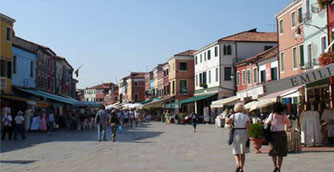Piazza San Marco
St. Mark's Square Venice 30124 Italy
Piazza San Marco, or St. Mark's Square, is Venice's most famous square. What appears to be a rectangle is actually a trapezium, and when you look up at the basilica, the piazza seems enormous, although it is only 175m long. On both sides of the piazza are the "Procuratie" buildings, which housed the procurators of San Marco. The oldest of these (probably built by Codussi) are on your left when you face the basilica; Longhena built the ones on the right later, in 1640. The most recent buildings, commissioned by Napoleon in 1810, lie behind.
Ponte di Rialto
For a long time this was the only way to cross the Canal Grande. There was a bridge here at the end of the 12th century, but the current one, designed by Antonio da Ponte, was built 1554-1591. There are now lots of shops on the bridge selling all kinds of souvenirs and curiosities and fresh fruit, vegetable and fish markets line the streets in the bustling neighborhood. While a second bridge was built in 1854, this bridge is still an important historical landmark and always a bright spot for tourists.
Basilica di San Marco
You get a splendid view from the tallest bell tower in Venice. It can be seen from the lagoon, and once you have reached the top, the whole lagoon can be seen from above. Even though the tower was erected at the beginning of the 20th century, it is an exact replica of the 15th-century bell tower. In 1609, Galileo Galilei exhibited his telescope here, and during the carnival, the bell tower used to serve as a stage for the tight rope-walkers who entertained the doge with their acrobatics.
Ponte dei Sospiri
Some legends say that the Ponte dei Sospiri was called the Bridge of Sighs because it was a rendezvous for lovers; however, the truth tells a much sadder tale. The bridge, in fact was built to convey magistrates to the courts and prisoners to their fates. However, the baroque bridge, designed by Antonio Contino, still has a very romantic air to it, and remains an important historical landmark in Venice today.
Monastero Mekhitarista
At the beginning of the eighteenth century, Armenian monks arrived in Venice. These monks fled from the Moorish country after the Turkish invasion. The Serenissima (Venetians) gave them an island, which was used as a lepers' colony in other times, hence its name 'San Lazzaro'. Under the guidance of Pietro Mechitar, the monks founded a religious order and monastery for the Mechitarists, and a library that became a cultural centre for the Armenian Diaspora. Fortunate enough to be spared by Napoleo.
Basilica dei Frari
First opened in the middle of the 13th century, this museum's collection was expanded up until the 16th century. It houses the 'Assunta' and the 'Madonna di ca' Pesaro', both by Titian, as well as the 'Madonna' by Giovanni Bellini, which is found in the chapel. The funeral monument to Titian, Canova and Francesco Foscari, is also here, as is the tomb of Monteverdi. The exhibition space is quite large. Call for admission details.
Basilica di San Marco
Started in the 9th century, this church's architecture shows
an eastern and Byzantine influence: note the golden altarpiece and
the 13th- and 14th-century mosaics that illustrate the cycles of the Bible.
The magnificent domes date from the 12th century. The Basilica houses the Marciano
Museum, which contains the original bronze horses, copies of which are now on the terrace.
Appreciation of the architecture is available 24 hours daily; the church is open for mass and
touring visitors to appreciate daily.
Back to top
